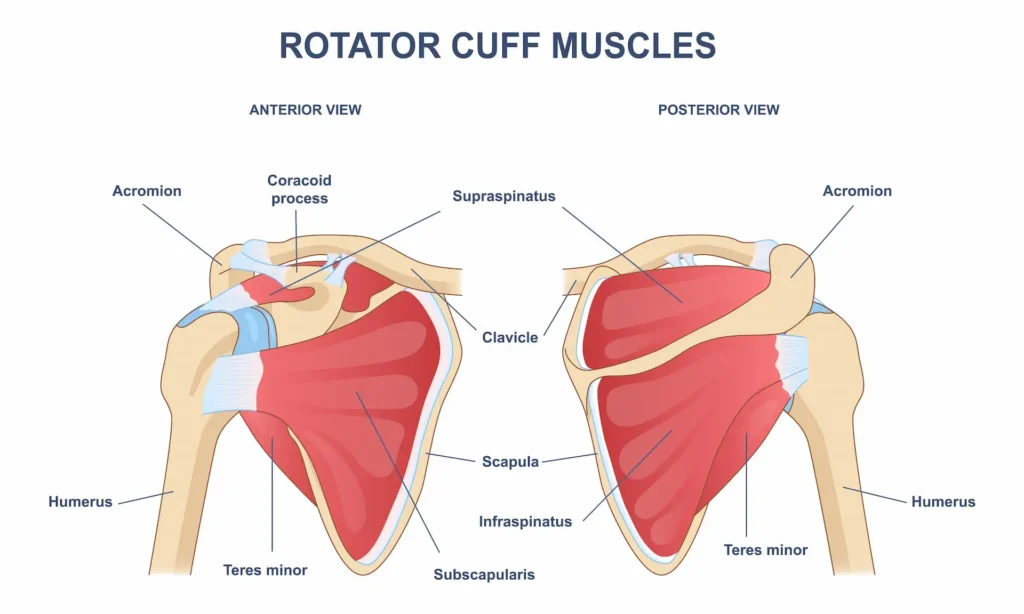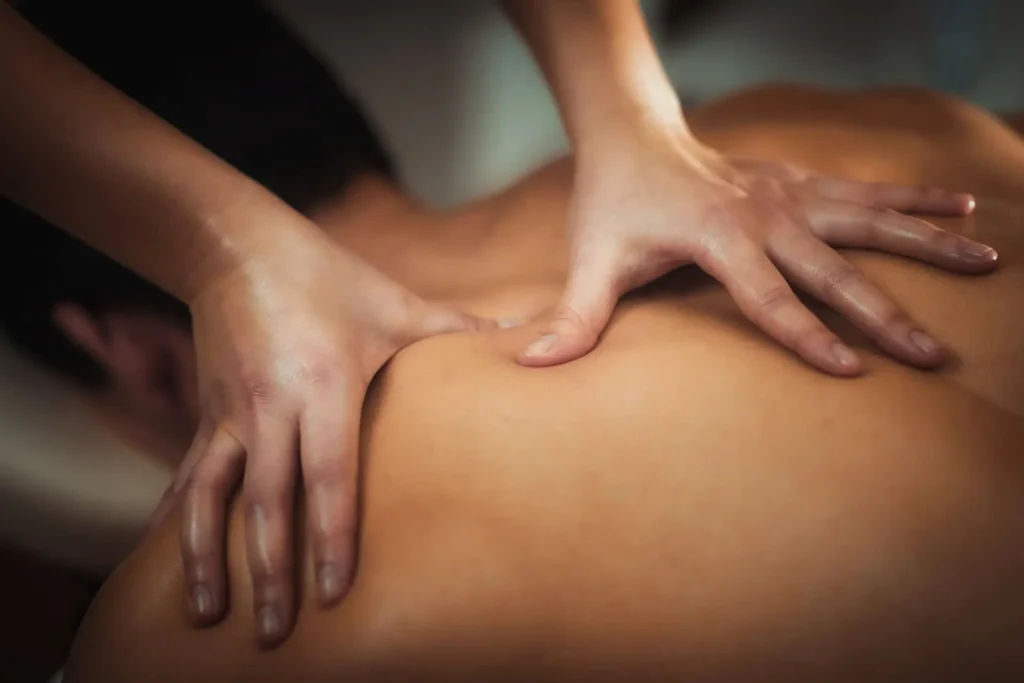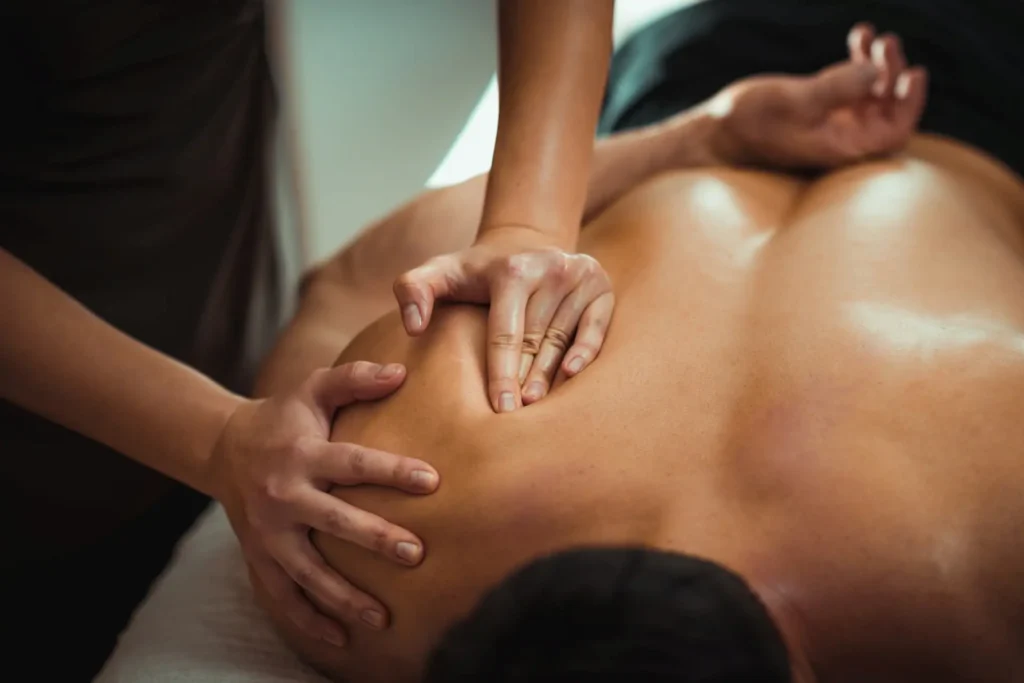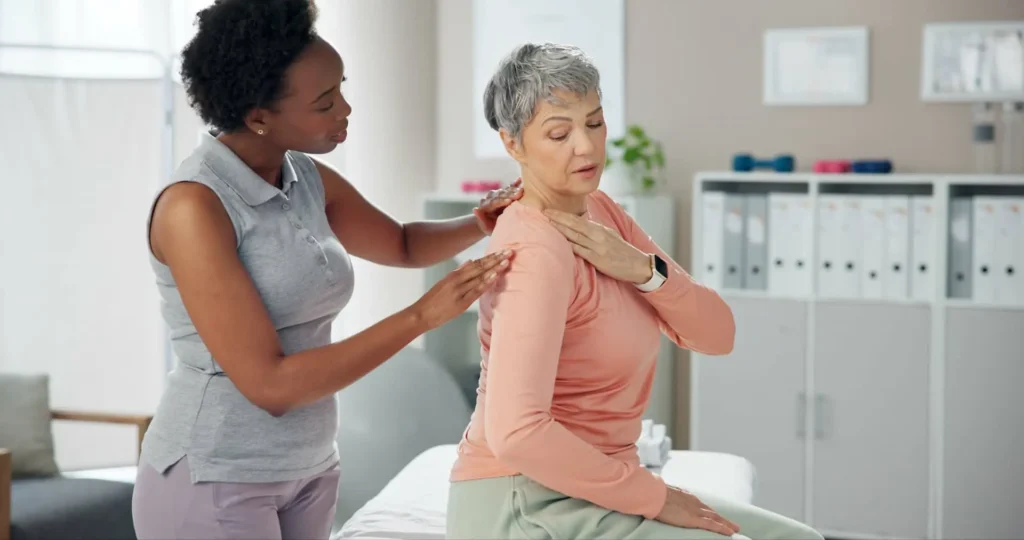If you’ve ever reached for your coffee mug and felt a lightning bolt of pain shoot through your shoulder, you might be dealing with a rotator cuff injury. As a bodywork therapist, I’ve seen that moment of realization countless times in my practice. That sudden grimace, the protective way people start to hold their arm, the frustration in their eyes when simple tasks become painful challenges.
That’s the thing about rotator cuff injuries – they don’t typically get better on their own, and they have a sneaky way of impacting nearly everything you do.
The good news? You don’t have to live with the pain, limited range of motion, or the constant fear of your shoulder “giving out.” Through years of working with clients with shoulder issues, I’ve seen firsthand how the right therapeutic approach can make a world of difference.

Your rotator cuff isn’t a single muscle – it’s actually a team of four muscles and their tendons that surround your shoulder joint like a cuff (hence the name). These muscles are the supraspinatus, infraspinatus, teres minor, and subscapularis. Together, they stabilize your shoulder joint and allow you to lift and rotate your arm.
Rotator cuff injuries typically happen for one of these reasons:
Just last month, I worked with a client who developed a rotator cuff injury from his weekend warrior tennis matches. He didn’t think much of the initial twinge until he couldn’t serve the ball without intense pain. After four sessions of targeted bodywork, he was back on the court with modifications, and after eight, he was playing full matches again.

When you’re dealing with a rotator cuff injury, traditional medical approaches often include rest, anti-inflammatory medications, and potentially surgery for severe cases. These all have their place, but they’re missing a crucial piece of the puzzle: addressing the soft tissue restrictions, trigger points, and movement patterns that both contribute to and result from the injury.
That’s where bodywork therapy comes in.
Bodywork doesn’t just treat the symptoms – it helps fix what’s really causing the pain by:
The best part? Many clients start feeling better within 3 to 6 sessions, although full recovery usually takes longer depending on how serious the injury is.

Not all bodywork methods work equally well for rotator cuff injuries. We use proven approaches that give the best results for shoulder healing. Here are the most helpful techniques we use:
The fascia (thin tissue covering your muscles) can get tight after an injury, limiting how your shoulder moves.
Myofascial release uses gentle, steady pressure to stretch the fascia and free it up. We also use heat therapy to help the fascia loosen up more easily.
For rotator cuff injuries, we focus on:
One client, a hairstylist with ongoing shoulder pain, said after treatment it felt like “finally being able to take a full breath through my shoulder.” This perfectly describes what happens when tight fascia is released.
Those sore, knotty areas in your muscles are trigger points, and they often cause rotator cuff pain. What makes trigger points tricky is they can cause pain in other areas, making it hard to find the real source.
With trigger point therapy, we apply specific pressure to release these knots. Key areas for shoulder injuries include:
I remember working with a construction worker who had seen many doctors for his shoulder pain. When we released a major trigger point in his infraspinatus muscle, he said, “That’s it! That’s the exact pain I’ve been trying to describe for months!”
Your shoulder is the most mobile joint in your body, but that mobility comes at a cost – stability. When injured, your shoulder joints can become stiff in some directions or too loose in others.
Joint therapy uses gentle movement techniques that:
These techniques work with your body’s natural movements rather than forcing anything. The results can be immediate and significant.
Healing from any injury needs good blood flow, which is where cupping therapy helps. By creating a gentle suction on the skin, cupping:
For rotator cuff injuries, we use both stationary cupping (cups placed in one spot) and moving cupping (sliding the cups across tissues). The temporary marks left by cupping show areas of tightness and poor circulation – exactly what needs addressing for healing.
A marathon runner I treated noticed that cupping not only helped her shoulder pain but also improved her recovery between runs. “It’s like my whole body works better when my shoulder isn’t hurting,” she said.
Sometimes we need to target scar tissue, especially in long-term injuries. Gua Sha uses a smooth-edged tool to apply pressure and friction to specific areas.
For rotator cuff injuries, Gua Sha helps:
While it can temporarily redden the skin, many clients find the relief worth it. “I had more movement after one Gua Sha session than six weeks of exercises I was given,” said one client with a partial rotator cuff tear.
As healing progresses, careful stretching becomes important for regaining full movement. Unlike stretching by yourself, assisted stretching allows for:
We carefully adjust stretching based on your healing stage – too much too soon can harm recovery, while too little for too long can allow stiffness to develop.

Healing from a rotator cuff injury isn’t linear – there are typically ups and downs along the way. Here’s what a typical recovery timeline might look like with regular bodywork sessions:
During this initial inflammatory phase, our approach is gentle:
As inflammation subsides, we can be more direct:
This is where the real transformation happens:
Throughout this process, we work closely with any other healthcare providers you’re seeing to ensure a coordinated approach.

No two rotator cuff injuries are exactly alike, which is why we tailor our approach to your specific situation:

While professional bodywork helps a lot, what you do between visits matters too. Here are some effective self-care tips I recommend:
One client improved greatly just by changing how she carried her heavy purse and taking “shoulder breaks” at work. These small changes make a big difference!
When it comes to rotator cuff injuries, recovery isn’t always straightforward, especially when you’ve been dealing with pain for decades. That’s what makes this next story so powerful.
This client had spent over 35 years staying active, but almost always with some form of tendonitis tagging along, from tennis elbow and plantar fasciitis to rotator cuff issues and IT band syndrome. She had gone through cortisone shots, surgeries, physical therapy, and the exhausting cycle of rest and flare-ups.
By 2023, she was battling severe piriformis pain. That’s when a physical therapist referred her to me. After just one session, she described the soreness as “a good pain,” and more importantly, she started to feel better. That began a consistent schedule of treatments every 2 to 4 weeks, focusing on hips, IT band, and piriformis. The result? She was power walking pain-free and enjoying nearly two years without tendonitis.
Then came a setback. Rotator cuff pain returned after overdoing it with downward-facing dogs. But this time, instead of surgery, we treated the shoulder directly. Four days later, the pain was 99% gone.
“Bob treated my right rotator cuff on a Saturday. I was bruised and sore for 3 days, but by the fourth day the pain was 99% gone! My rotator cuff fixed in only 3 days! The pain from surgery was so much worse than the pain from my inflamed rotator cuff. I couldn’t lift my arm past my shoulder for 6 months after surgery and Bob fixed it in 3 days!
I will continue to see Bob every 2 or 3 weeks. Once the pain from an injury is gone, the treatments are very relaxing and pleasurable and really keep me fluid and moving well.”
-Barbara S.
Her story is a reminder that your body can heal — even after decades of chronic pain and setbacks. With consistent bodywork, the right approach, and a bit of trust in the process, recovery doesn’t have to mean surgery or endless downtime. Sometimes, it means finding the right hands at the right time.

Living with rotator cuff pain isn’t just about the physical discomfort – it’s about all the things the pain prevents you from doing. The simple joys of playing with your kids, gardening on a nice day, or even just getting a good night’s sleep without shoulder pain shouldn’t be out of reach.
At Bodywork Masters, we’ve helped many clients move from pain and limitation to freedom and function. Our integrated approach addresses not just the symptoms but the root causes of your rotator cuff injury.
If you’re tired of modifying your life around your shoulder pain, it’s time to take action. Contact Bodywork Masters today to schedule your comprehensive assessment and take the first step toward healing. Your shoulders carry enough – they shouldn’t have to carry pain too.